
1
48h
15-22°
30-75% RH
Cement < 2,5% CM
CaSo
4
< 0,5% CM
1 m
>2 mm
>1 mm
20 cm
www.quick-step.com
i
www.quick-step.com
i
1 2 3 4
1. PREPARATION
1
Let the planks acclimatize for 48 hours in the unopened packaging at the normal room temperature, in the middle of the room where the
floor is to be installed. The ideal conditions are 15-22°C at a relative humidity of 30-75%. If climate conditions are outside this 30-75%
range, we strongly advise to acclimatize for 1 week with opened packages.
2
Remove any damp-porous floor covering (carpet, needle felt, etc.) first. Damp-sealed floor covering (PVC, linoleum, VCT, etc.) does not
have to be removed. Always use an underlay. We advise to use a Quick-Step underlay.
3
WOODEN SUBFLOOR: Remove any existing floor covering first. No signs of mould and/or insect infestations should be present. Make
sure the subfloor is level. Nail down any loose parts. If the wooden subfloor is flat (no unevenness greater than 2mm over the length of 1
meter): you can install any QS underlay. If the wooden subfloor is not flat and has uneveness > 2mm and < 4mm (because of cupping of
the wooden subfloor planks: you can install the QS Thermolevel underlay. If the wooden subfloor is not flat and has unevenness > 4mm:
you have to install a fibered levelling compound or underlay + plywood / OSB levelling floor.
Install the new floor at ninety degrees to the existing subfloor. The crawl space under the plank floor must be sufficiently ventilated.
Remove any obstacles and make sure there is sufficient ventilation (minimum 4 cm² (1/2”) total ventilation openings per m² (40”) of
floor). The moisture content of the wood must not exceed 10%.
4
Additional instructions apply if there is underfloor heating or cooling. Your dealer or installer of the floorheating system must guarantee
that the floor surface temperature never exceeds 28 degrees °C. Visit www.quick-step.com for more information.
5
A new concrete floor must dry at least 1 week per 1 cm (3/8”) thickness up to 4 cm (1-1/2”). Thicknesses over 4 cm (1-1/2”) require
twice as much drying time. For example, a 6 cm (2-1/2”) concrete subfloor must dry for at least 8 weeks. The moisture content must be
less than 2.5% for cement-bound screed (CM method) and 0.5% for an anhydritebound screed. As the drying times are really depending
on the climate conditions and the ventilation of the building, these timings are only indicative.
6
Make sure the subfloor is level. Any unevenness greater than 2 mm over the length of 1 meter must be smoothed out. The same applies to
any unevenness of more than 1 mm over a length of 20 cm.
5 6
1. PREPARATION 2. INSTALLATION 3. FINISHING 4. MAINTENANCE
INSTALLATION INSTRUCTIONS FOR QUICK-STEP LAMINATE
WITH HYDROSEAL TECHNOLOGY.
IN ORDER TO OBTAIN A GOOD RESULT, WE ADVISE TO FOLLOW ALL GIVEN INSTRUCTIONS CAREFULLY.

2
8 9 10
7
7
Make sure that the floor base is flat, clean, firm, and dry.
8
To install your laminate floor you need the following standard tools: Hammer, saw (a jig-saw, hand circular saw, hand saw, or cross-cut
saw), pencil, tape measure, safety goggles and gloves.
9
Apart from that, you also need the following accessories: installation kit (a pulling iron, spacers and a tapping block suitable for the
Uniclic
®
click system), underlay system (use an underlay that provides a stable foundation for the floor, such as the Quick-Step Unisound
underlay) and suitable maintenance products. The use of accessories other than the Quick-Step accessories might cause damage to the
Quick-Step floor. In such case the guarantee provided by Quick-Step will be void. We therefore advise to use only Quick-Step accessories
as these have been especially designed and tested for the use with Quick-Step floor panels.
10
Check all panels before and during installation. Defective panels must never be used.
11
Check whether the old skirting can be removed. You can leave the wall skirting boards in place and finish the floor with Quick-Step
profiles or cover the existing skirting boards with the Quick-Step cover skirting board.
12
Check that the doors can still open and close after the floor and underlay have been installed.
13
Cooking islands for kitchens and other very heavy objects should be installed first and not placed on top of the laminate.
The laminate floor must be able to move around the heavy objects to avoid open joints and separating planks.
1. PREPARATION 2. INSTALLATION 3. FINISHING 4. MAINTENANCE

3
1
A =
> 40 mm
2
3 4
8-10 mm
5
2. INSTALLATION
The floors with hydroseal technology are water resistant after installation. Following these instruction carefully makes the floor fit for use in
bathrooms, kitchens, laundry rooms and entrance areas. The panels are not suitable for use in damp spaces like pool areas, saunas and
rooms with build-in drains like showers. These extra water protection instructions do not cope to national regulations of water protection in
wet rooms.
With Uniclic
®
panels you can choose where you want to begin. Think about what will be the easiest way to install the floor. We will
demonstrate the installation for right-handed people, from left to right. You can work in the other direction if you want.
Uniclic
®
is unique because you can install the planks in two different ways. Method A: Position the panel to be installed at an angle of
20 to 30° to the panel already installed. Move the panel gently up and down and at the same time exert forward pressure. The panels
will automatically click into place. You can either insert the tongue into the groove, or the groove on to the tongue. The tongue in groove
method is the most common and easiest way. Method B: With Uniclic
®
you can also tap the panels into each other without lifting. For this
method you must use the special Uniclic
®
tapping block. The planks should not be joined with a single tap. To avoid damaging the panels
you must tap them together gradually.
1
Make sure the panels are mixed sufficiently when you install them, so that you do not end up with too many identical, light or dark panels
next to eachother. To obtain the best visual effect, it is best to fit the floorboards in the direction of the longest wall and parallel to the
incidence of light.
2
Before starting, carefully measure the length and the width of the room to plan a precise layout to achieve a balanced appearance of
the floor. This is very important when installing typical tile decors. This will ensure also you won’t end up with the last row being too
narrow. If the last row would be less than 40mm, the installation will be easier if you cut down the planks of the first row in the length.
3
First install the underlay, per width and gradually as you progress. It is vital that you use underlays to smooth any unevenness in the base
floor. The specially designed Quick-Step underlays have a damp-proof, insulating, noise-reducing and leveling function. The smooth top
surface makes installing the laminate panels easier and ensures ample expansion afterwards. You can find more information about
Quick-Step underlays and how to install them on the underlay packaging or at your dealer.
4
Begin the first row with a whole plank. First saw off the tongue on both the long and the short sides.
5
Put the plank with sawn off sides against the walls. Put spacers from the installation kit between the planks and the wall. This will ensure
that your expansion joint is wide enough: 8 to 10 mm (5/16” to 3/8”).
6
Of course we also need to saw the panels. To obtain a clean cut, the pattern side should face down when you use a jigsaw, sabre saw or
circular handsaw and up when you use a handsaw or a crosscut saw. Ensure that the end joints of the panels in two successive rows are
never in line. Always ensure that the joints are staggered by at least 30 cm / 12 inches.
1. PREPARATION 2. INSTALLATION 3. FINISHING 4. MAINTENANCE
6

4
3
4
1
1
2
3
1
2
3
3
7b 7c
146
23 5
69
10
11
7
Position the panel to be installed at an angle of 20 to 30° to the panel already installed. Move the panel gently up and down and at the
same time exert forward pressure. The panels will automatically click into place.
8
With Uniclic
®
you can also tap the panels into each other without lifting. For this method you must use the special Uniclic
®
tapping block.
The planks should not be joined with a single tap. To avoid damaging the panels you must tap them together gradually.
9
In places where it is too diffi cult to install the Unilic
®
planks with the tapping block (e.g. against the wall), you can tap them together using
the pulling iron and a hammer.
10
Once enough rows are installed, it is easy to continue the installation as follows: Put an unopened pack of panels on the already installed
rows. Switch your position and click the short side of the panel in the previous panel.
11
Now place your BOTH hands close to the joint as shown in the fi gure and pull the long side of the plank towards you. The panels will now
click together.
1. PREPARATION 2. INSTALLATION 3. FINISHING 4. MAINTENANCE
7a
8

5
8-10 mm8-10 mm
>13m
>13m
>13m
8-10 mm8-10 mm
13
615
12
Continue like this to the end of the room.
13
With lengths of more than 13 m and widths of more than 13 m, there should be an intermediate expansion joint. The swelling and
shrinking is linear, so the bigger the surface, the bigger the play at the edge has to be.
14
Room humidity can vary according to the season, so it is vital that the fl oor is able to expand and contract. For this reason, make sure you
leave an expansion joint of minimum 8 to 10 mm (5/16” to 3/8”) on all sides of the fl oor, around pipes, thresholds and under doors.
Expansion joints can be fi nished by means of a skirting that is attached to the subfl oor. It is mandatory to provide an expansion joint
between diff erent rooms (e.g. under the door).
15
Remove all spacers.
1. PREPARATION 2. INSTALLATION 3. FINISHING 4. MAINTENANCE
146
23 5
78 9
10 11 12
13 14 15
16 17 18
12
14

6
ONE 4 tALL GLUE
8-10 mm
+20 mm
8 -10 mm
1 2 3 4 5 6
1. PREPARATION 2. INSTALLATION 3. FINISHING 4. MAINTENANCE
3. FINISHING
1
Install the skirting-board against the wall.
Never attach the skirting-board to the floor. This method allows the floor to expand and contract under the skirting-board. In places where
profiles or skirting-boards cannot be placed, fill expansion joints with elastic paste (Quick•Step
®
Kit).
2
When sawing the panels make sure that the expansion joint under the door is at least 10 mm. If you cannot lift the panel, use the tapping
block or pulling iron and hammer to tap the panels together when the planks are flat on the floor.
3
In rows where there is a pipe, make sure the pipe falls exactly in line with the short side of two panels. Take a drill bit with the same
diameter as the pipe plus 20 mm (3/4”). Click the panels together on the short side and drill a hole centered on the joint between the two
panels. Now you can install the panels on the floor.
4
In rows where there is a double pipe, proceed as follows: 1. Measure where the pipe will come through the plank. Don’t forget to allow
for the expansion joint 2. Take a drill bit measuring the diameter of the pipe plus +20 mm for the expansion. Drill through the panel where
the pipe will come through 3. Extend the hole to the edge of the panel 4. Lay the panel around the pipe 5. Take another panel and saw a
piece that fits exactly in the remaining hole, and glue this piece with wood glue.
5
For a perfect finish around pipes, use Quick•Step
®
pipe covers or an elastic paste (Quick•Step
®
Kit).
6
In places where it is difficult to install the planks with the tapping block (e.g.underneath radiators), you can tap them together with the
pulling iron and a hammer.

7
Q
S
H
Y
D
R
O
K
I
T
Q
S
H
Y
D
R
O
K
I
T
Q
S
H
Y
D
R
O
K
I
T
Q
S
H
Y
D
RO
K
I
T
Q
S
H
Y
D
R
O
K
I
T
Q
S
H
Y
D
R
O
K
I
T
1 2 3 4 5 6
1. PREPARATION 2. INSTALLATION 3. FINISHING 4. MAINTENANCE
3. FINISHING IN ROOMS LIKE BATHROOMS, KITCHENS, LAUNDRY ROOMS AND ENTRANCE AREAS
1
Sealing the perimeter expansion joints combines a compressible PE foam with diameter 8 to 10 mm and the flexible and waterproof
Quick-Step
®
HydroKit. Push the PE foam in the expansion joints and apply the flexible Quick-Step
®
HydroKit under slight angle towards
the Quick-Step
®
floor.
2
Install the skirting-board with Quick-Step One4all glue. Apply the flexible HydroKit between skirtings and floor to avoid ingress of water.
In places where profiles or skirting-boards cannot be placed, fill expansion joints with elastic paste (Quick-Step
®
Kit).
Tip: To make work more clean it can be easy to put a tape on the floor before applying the flexible HydroKit. This tape can be removed
immediatly after applying the HydroKit. Spilled HydroKit can be removed easily when it is dry.
3
Fix the Incizo base profile to the base floor with Quick-Step
®
One4all glue and/or screws. Apply the flexible HydroKit on the flexible PE
foam that is in the expansion joint.
4
Push the Incizo profile in the base profile and the wet HydroKit.
5
For a perfect finish around pipes, use Quick-Step
®
pipe covers and the elastic waterproof transparant Quick-Step
®
HydroKit on top op
the PE-foam. Then place the pipe cover and apply HydroKit around the pipe cove and around the tubes. This makes the ingress of water
impossible.
6
To secure extra water protection around the perimeter of the floor and avoid water to enter underneath the panels, apply the flexible
Quick-Step
®
Hydrokit up to the wall base, thresholds, door frames, pipe covers etc.

8
<24h.
www.quick-step.com
i
type ‘w’
H
2
0
1
5
2
6
3a 3b
4
1. PREPARATION 2. INSTALLATION 3. FINISHING 4. MAINTENANCE
4. MAINTENANCE
You can immediately walk on your new Quick-Step Laminate floor after installation.
1
You can walk on the floor during and immediately after installation. Ensure that humidity in the room is always at least 50%. Use a
humidifier if you need to.
2
For dry maintenance, we advise a Quick-Step mop or vacuum cleaner. Make sure the vacuum cleaner is equipped with soft wheels and
a special parquet brush to avoid scratches on your floor. You can use a steam cleaner on a water resistant Laminate if there’s no steam
directly coming on the laminate. So it must always be used with an appropriate cloth on the steam opening, which guarantees also an
homogeneous heat and steam distribution. It is also important to take care to hold the apparatus not too long on the same place and
clean the floor in the length direction of the planks.
3
For slightly damp and wet maintenance, we advise the Quick-Step maintenance set (see instructions). Be aware that the use of other
cleaning products might damage your floor.
4
Remove any water within 24 hours.
5
Protect furniture and chair legs. Avoid bringing dirt, water and sand indoors by providing a suitable floor mat at the door. Use (office)
chairs and seats with soft wheels that are suitable for a laminate floor and/or use a suitable desk mat.
6
Never drag items of furniture over the floor, but lift them up.
7
The smooth surface of your laminate floor will not retain dirt or dust. Remove stubborn stains carefully with acetone or nail polish remover.
Never use scouring products! Never use wax or varnish coating on the floor.
-
 1
1
-
 2
2
-
 3
3
-
 4
4
-
 5
5
-
 6
6
-
 7
7
-
 8
8
Quick-Step SDH2402 Operating instructions
- Type
- Operating instructions
Ask a question and I''ll find the answer in the document
Finding information in a document is now easier with AI
Related papers
Other documents
-
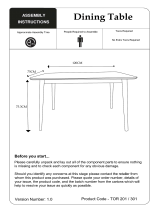 Julian Bowen TOR201 Assembly Instructions
Julian Bowen TOR201 Assembly Instructions
-
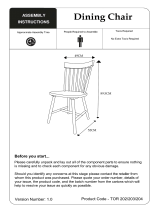 Julian Bowen TOR203 Assembly Instructions
Julian Bowen TOR203 Assembly Instructions
-
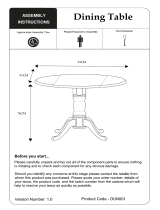 Julian Bowen DUN001 Assembly Instructions
Julian Bowen DUN001 Assembly Instructions
-
Howdens SDH3599 Operating instructions
-
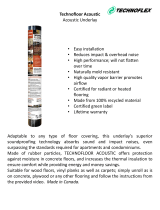 Technoflex M2000-100HD User manual
Technoflex M2000-100HD User manual
-
Orbit 27483 Installation guide
-
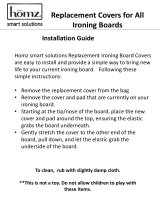 HOMZ 1915065EC.01 Installation guide
HOMZ 1915065EC.01 Installation guide
-
Howdens SDH3589 Operating instructions
-
Dundee Deco REHD186FB-10 Operating instructions
-
Howdens SDH3692 Operating instructions














